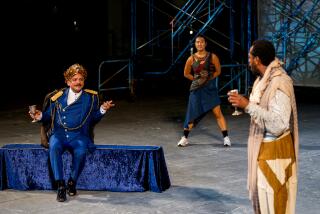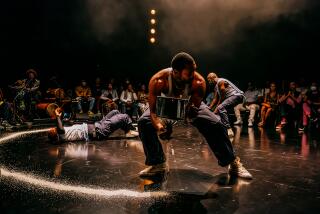Critic’s Notebook: How Jackie Sibblies Drury brings conceptual brilliance to a play about black caregivers
At a time when the politics of identity has become a central subject of theatrical inquiry, it’s only fitting that African American dramatists have been leading the charge.
With their divergent aesthetics and experiential perspectives, Suzan-Lori Parks, Lynn Nottage, Robert O’Hara, Tarell Alvin McCraney and Branden Jacobs-Jenkins have been re-examining American identity in racial, historical and springy existential contexts. They have been joined by such rising talents as Jeremy O. Harris and Aleshea Harris, who are bringing brash fearlessness to a national conversation that is growing only more heated.
Jackie Sibblies Drury stands out in this richly talented field with her conceptual brilliance. “Fairview,” which was the most breathtakingly innovative play I saw last year, theatricalizes the warping effect of white narratives on black bodies. “Marys Seacole,” her new play at Lincoln Center Theater’s Claire Tow, explores the sanctity and sacrifices, along with the seething resentments, of caregivers in a drama that moves with the rippling relentlessness of a pond after a violent storm.
Combining strands of theatrical DNA from Adrienne Kennedy and Caryl Churchill, “Marys Seacole” finds an original frame to expand the biographical story set within it. At the center of the play is the figure of Mary Seacole, the Jamaican-born 19th century Scottish-Creole nurse and entrepreneur whose autobiography, “Wonderful Adventures of Mrs. Seacole in Many Lands,” tells the tale of a woman who refused to be confined by race, gender or geography.
The odd pluralization of “Mary” in the title indicates that Drury is not focusing solely on the historic Mary Seacole (a statue of whom stands outside St. Thomas’ Hospital in London), but on the many women who have walked in her care-giving path. Quincy Tyler Bernstine plays not only Mary Seacole but also the other Marys in the play who have dedicated their lives to those unable, because of sickness, injury or age, to take care of themselves.
With implacable authority, Bernstine’s Mary Seacole introduces herself through a series of scene or chapter titles before filling in some essential details of her biography. She traces to her Scottish solider father “her affection for a camp-life, a war-life.” But it was from her Jamaican mother, “an admirable doctress” who kept a boardinghouse in Kingston, that she says she inherited her “yearning for medical knowledge.”
This opening monologue, delivered almost as though a memorial statue has been brought to life, is straightforward in its theatricality. Bernstine’s portrayal of Mary Seacole exudes a 19th century gravitas, but the surrounding setting is unmistakably the contemporary stage.
Another figure, Duppy Mary (played with silent maternal severity by Karen Kandel) places a Bluetooth wireless earpiece in Mary’s ear. A few moments later, Bernstine cries out, “Forward, hasten forward, Mary.” As Mary Seacole adumbrates her experience as a life-saving healer during a cholera epidemic in Jamaica and later as a nurse in the Crimean War, the scene gradually transforms around her into a modern-day nursing home.
The new Mary that Bernstine portrays (a metamorphosis aided by Kaye Voyce’s time-setting costumes) is a no-nonsense nurse in a generic facility. Merry (Marceline Hugot), an elderly woman hooked up to a machine, lies unresponsively in bed. May (Lucy Taylor), Merry’s daughter, talks animatedly about photos in an album while anxiously wondering why no one has come to feed her mother. Miriam (Ismenia Mendes), May’s sullen daughter, squirms in her seat as her mother forces conversation.
It matters that Merry, May and Miriam are white and that Mary and her assistant, Mamie (Gabby Beans), are black and speak with a Jamaican accent, because Drury is tracking, among other concerns, the racial dynamics of the caregiver-patient relationship. May complains that her mother isn’t getting adequate attention, but Mary hasn’t time to massage the feelings of family as she follows her own intimate knowledge of her patients’ needs. Her clinical chill, however, masks deeper resentments.
SPRING PREVIEW: Critic’s picks for the season’s most promising theater »
Like Kennedy’s “Funnyhouse of a Negro,” “Marys Seacole” situates a central protagonist in a hall of mirrors, where the past blurs into the present and subjective experience rams against objective reality. The drama is hallucinatory, though not in Kennedy’s lyrically cathartic way.
The structure of “Marys Seacole,” while intuitive to a degree, has an intellectual distance that brings to mind the playfully abstract dramaturgy of Churchill (“Top Girls,” “A Number”), whose interest in the personal is similarly subsumed within the political. Drury, author of “We Are Proud to Present a Presentation ...,” shares Churchill’s love of open theatricality as well as her resistance to conventional psychological realism. Sentimentality has been gutted from her new play, but emotion, an ancestral sorrow that never ends, flows under the surface.
Behind the adventurous spirit of “Marys Seacole” is a determination not to allow the audience to get ahead of the play. The drama keeps shifting between Mary Seacole’s struggles to carve a place for herself as a healer and an independent businesswoman and the various other modern Marys who perform the societal work others want to offload. The dramatic movement is associative and circular: We move from Mary at her hotel in Jamaica saving lives to nannies at the park gabbing on a workday, from an instructor overseeing an educational enactment at a trauma center to Mary tending to her “British sons” on the Crimean battlefield.
One of the ironies of “Marys Seacole” is that the various characters who care for the helpless, dying, wounded and infirm can’t afford to be soft as they navigate their way in a world that depends on this labor but doesn’t fairly compensate it. (“Bloodied hands, thankless work,” the words of a white woman comparing Mary to a Greek tragic heroine, sums up the calling.) Bedpans have to be changed; children have to be watched. But those who pay for this work are often too steeped in their own guilt and selfishness to fully acknowledge its value.
Drury maps this tension onto the problematic way society organizes itself racially, economically and geopolitically. If this sounds didactic, “Marys Seacole” is too fluid to be programmatic.
The play resists tying up its various threads into a message or moral. Instead of building toward a climax, there’s a seismic intensification. The anger of these worn out yet unstoppable women ratchets up into a rage as the voices that have been swirling combine into a cacophony of conflict and distress.
‘DIANA’: Princess’ story told through a very American musical »
Duppy Mary, who smolders mutely throughout most of the play, eventually gives voice to the caregivers’ bottled-up fury in a monologue that functions as an explosive device:
You go there and they will make you work and
mock you while you do it.
You go there and they will not see you as human being with a soul and a
morality and a vitality they will see you as worse than a dog
worse than a slave. At least for them slaves is property.
Them need us but them nah want us. …
There are moments when Lileana Blain-Cruz’s excellent production, departing from the clean lines of its attractive modern tableaux, tries to supply what is absent in the playwriting. Whitney Houston’s cover of “I’m Every Woman,” which bursts through at one point, enlivens without really enlightening. In the final movement, the lighting (Jiyoun Chang) and sound (Palmer Hefferan) become more foreboding as the blocking grows more manic on Mariana Sanchez’s flexible postmodern set. But the play’s elusiveness grows only louder.
The abundance of thematic options seems to preclude closure. Bernstine’s Mary, a groundswell of a performance wholly rooted yet vibrating across centuries, makes a powerful assertion of autonomous selfhood when she utters the word “me” from the depths of her being. But the din continues to escalate as the women band together into a volatile chorus.
Drury’s dramatic poetry refuses to be domesticated by interpretation. But one thing is clear: In a world divided between “those who comfort and those who are comforted,” the Marys Seacole of the world must fight to preserve their dignity and strength.
More to Read
The biggest entertainment stories
Get our big stories about Hollywood, film, television, music, arts, culture and more right in your inbox as soon as they publish.
You may occasionally receive promotional content from the Los Angeles Times.











